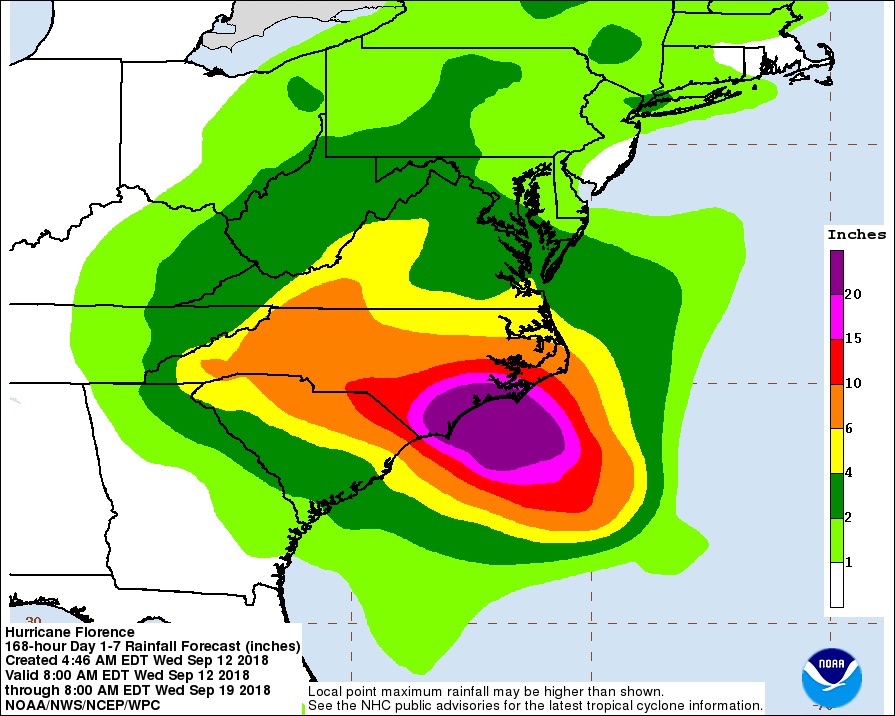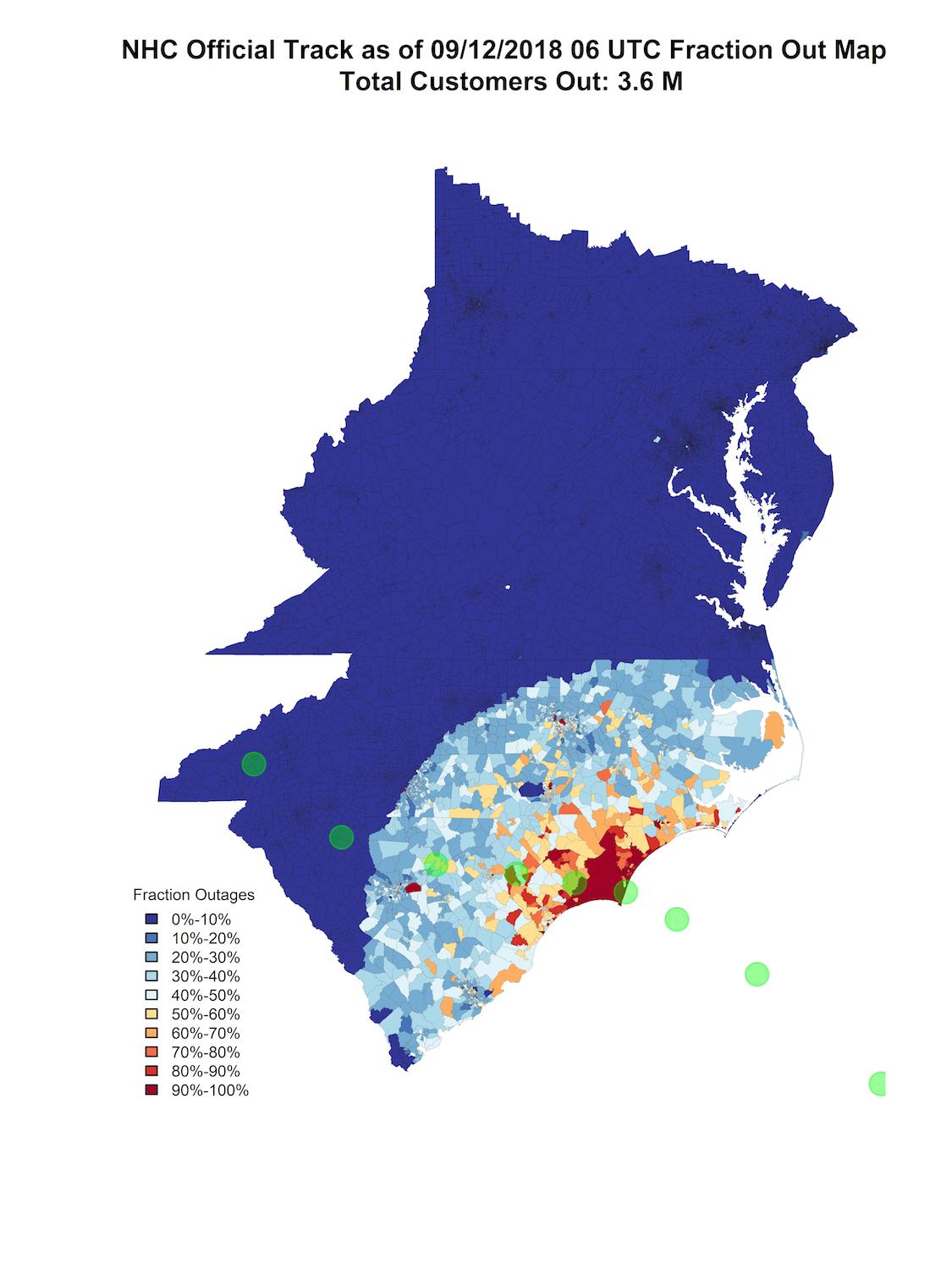'Nightmare' Hurricane Florence Poses Far-Reaching Dangers
So, what's the worst that could happen?
Astronaut and geophysicist Alexander Gerst called Florence a "nightmare" after glimpsing its eye from the International Space Station this morning, saying in a tweet: "Get prepared on the East Coast, this is a no-kidding nightmare coming for you."
Despite the public's fascination with high winds, it turns out that most of the damage could come from the historic amounts of water the hurricane releases, climate and health experts told Live Science. [Hurricane Florence: Photos of a Monster Storm]
"This storm is about flooding," Perry Samson, a professor of climate and space science at the University of Michigan, told Live Science.
As of 2 p.m. EDT today (Sept. 12), Florence was a Category 3 hurricane with winds of 125 mph (205 km/h) at its location about 435 miles (700 kilometers) southeast of Wilmington, North Carolina, according to the National Hurricane Center in Miami.
Florence is expected to make landfall late Thursday or early Friday (Sept. 13 or 14), likely as a Category 3 hurricane, meaning it will have winds blowing at a minimum of 111 mph (178 km/h), Samson said.
As hurricane-force winds approach the coast, they'll push the ocean's waves ashore, causing storm surges of up to 13 feet (4 meters) in parts of North Carolina, the National Hurricane Center reported. Coastal North Carolina may receive up to 40 inches (100 centimeters) of rain, the National Hurricane Center said. (To put that number in perspective, the rainy city of Seattle gets just over 37 inches (94 cm) of rain each year.)
Sign up for the Live Science daily newsletter now
Get the world’s most fascinating discoveries delivered straight to your inbox.

Then, as the high-pressure system steering Florence weakens, the hurricane is expected to hang out inland for days, showering the region with rain much like Hurricane Harvey did to Houston last year.
All that water is worrisome for a region that just had a rainy season, meaning the soil there is fairly saturated and the rivers there are already high. "So, there's not a lot of capacity to soak up the extra water," Samson said.
Moreover, high tides around noon and midnight these next few days will make the storm surges even worse, Samson said. "If you haven't already evacuated, shore up your house as best you can," Samson recommended. "I would go visit a relative somewhere away from the shoreline."
What happens next
As for people staying put, the authorities used to advise that people get three days' worth of supplies, but now it's best to get two weeks' worth of supplies, Sue Anne Bell, an assistant professor of nursing at the University of Michigan, told Live Science.

That’s because in addition to the extensive flooding, the hurricane is expected to knock out power along the coast, according to an analysis done by a team headed by Seth Guikema, an associate professor of civil and environmental engineering at the University of Michigan. These power outages could last days to weeks, Brock Long, a spokesperson with the Federal Emergency Management Agency (FEMA), told Reuters.
In anticipation of the winds and water, 1.7 million people living along the coasts of the Carolinas and Virginia were ordered to evacuate ahead of the storm. [The 20 Costliest, Most Destructive Hurricanes to Hit the US]
Meanwhile, some of North Carolina's 2,100 industrial-size hog farmers are scrambling to drain waste pools containing manure before the hurricane hits, according to NPR. These pools are full of poop-eating bacteria that help break down the manure, but farmers don't want to see animal waste get into drinking water supplies. So, they're pumping the liquid out of the lagoons and spraying them as fertilizer on fields, which gives the lagoons more capacity to hold rainwater, NPR reported.
Floodwaters could also spread mercury-containing coal ash that's held in pits operated by Duke Energy, the state's main electricity company, the AP reported. But the company reported that wastewater levels inside the pits were low, and that "we’re more prepared than ever," Duke Energy spokesman Bill Norton told the AP.
The blasting wind and surging water may also damage some of the 16 nuclear reactors located in North Carolina, South Carolina and Virginia. Some of these reactors — including Duke Energy's Brunswick and Harris nuclear plants in North Carolina and Dominion Energy's Surry plant in Virginia — may be directly in the hurricane's path, Reuters reported.
However, since the Fukushima disaster in 2011, U.S. power plants have installed more safety equipment, such as waterproofing, portable pumps and generators, Duke Energy spokeswoman Mary Kathryn Green told Reuters. Some reactors are undergoing prestorm checks now, and their reactors will be shut down 12 hours before the hurricane arrives, Green said.
Original article on Live Science.

Laura is the archaeology and Life's Little Mysteries editor at Live Science. She also reports on general science, including paleontology. Her work has appeared in The New York Times, Scholastic, Popular Science and Spectrum, a site on autism research. She has won multiple awards from the Society of Professional Journalists and the Washington Newspaper Publishers Association for her reporting at a weekly newspaper near Seattle. Laura holds a bachelor's degree in English literature and psychology from Washington University in St. Louis and a master's degree in science writing from NYU.









